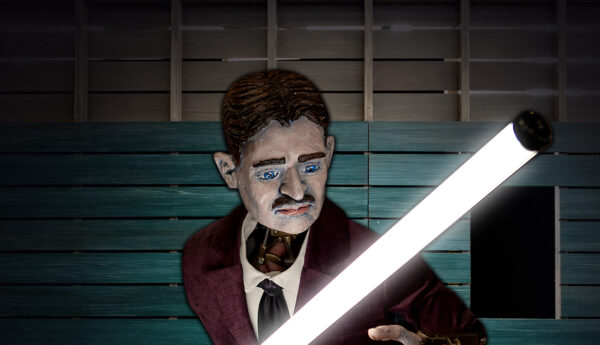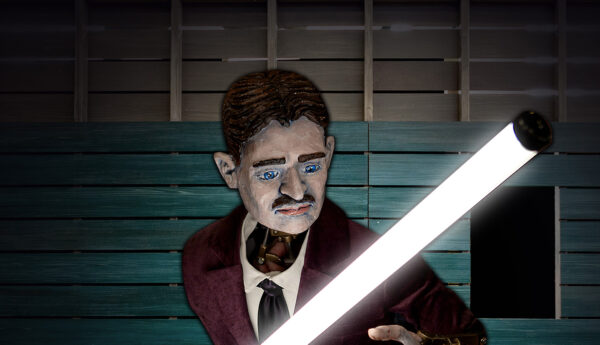Any time you plug in your near-dead phone, microwave a frozen meal or flick on a light switch, you should be thanking Austrian inventor Nikola Tesla. Though the light bulb was invented by Thomas Edison in 1880, electric lighting would not be as ubiquitous as it is today without Tesla’s invention of alternating currents in 1888 and advocacy for free, worldwide electricity.
The nonprofit museum Center for Puppetry Arts’ newest puppet show, “Tesla vs Edison,” premiered on Feb. 22 and is open until March 12. The show retells the story of Tesla’s conflict with fellow inventor and former friend Edison, using puppets of Tesla (Jake Krakovsky (14C)), Edison (Jason Hines), George Westinghouse (Alex Burnette), Mark Twain (Alex Burnette) and a pigeon (Sarah Beth Hester). The actors portraying the puppets double as puppeteers and independent performers in the narrative. Through incredible puppet craftsmanship, actors’ performances and a willingness to embrace the absurd, “Tesla vs Edison” captures the essence of what it means to create, analyzing the abuse of power and the fiction of history.

Courtesy of the Center for Puppetry Arts
The show begins with the four human performers entering the stage and clocking in for work using time cards. They rhythmically tinker away at machines, banging at them with hammers and twisting wrenches, before playing with various puppet parts, such as legs and a head. Twain, a historical friend of both Edison and Tesla, narrates the story, beginning with Edison’s invention of the phonograph and following Tesla’s work as Edison’s lab assistant and inventor for the domineering entrepreneur Westinghouse. The story reaches its climax as the conflict between Tesla’s alternating current and Edison’s direct current comes to a head, ending in Tesla’s greatest success: turning Niagara Falls into an alternating current power plant.
The linchpin of “Tesla vs Edison” was the beautifully crafted puppets and the way the puppeteers utilized them to tell the story. The show included rod puppets, handheld puppets, one-meter tall “half life-size” puppets and body puppets, which are costume-like puppets worn by the puppeteer. The different sizes of puppets enhanced both the aesthetic presentation and story. For example, Twain, who is represented by a handheld puppet, appeared in various locations around the set, such as in bookshelves and cabinets, making him a delightfully quirky addition to the cast. Varying puppet size also communicated thematic significance, such as power. In a later scene, Westinghouse, represented by a body puppet, criticizes Tesla’s frivolous expenditures and lack of focus in his work. Wesitnghouse’s enormous puppet overwhelmed the stage with its sheer size and towered over the smaller Tesla puppet, beautifully symbolizing the power Westinghouse had over Tesla’s life and work.
Furthermore, the puppets were incredibly expressive. After his confrontation with Westinghouse, Tesla cowered in fear, his entire wooden body trembling at the hands of his puppeteers. In an earlier scene, when Tesla first arrives in New York, he steps on some sort of gross substance on the street, causing him to visibly shudder in disgust. Though being made of wood, the puppet’s performances were not wooden, as Tesla and the rest of the casts’ body language provided meaningful characterization and contributed to the storytelling.
The puppets would not have been so emotive if not for the puppeteers’ incredible work. This show utilized full-view manipulation, a form of puppetry in which puppeteers are on stage, visibly seen manipulating the puppets. Thus, the performers were not just unseen puppeteers in the background; their presence on stage fully enhanced the artistic experience. They were completely integrated into the performance through costuming, donning late 1800s-style clothes and lab coats later in the play. At times, the performers moved freely without their puppets. In one scene, they played Edison’s quirky lab assistants, fetching supplies as Edison invented the light bulb. When acting as puppeteers, the performers truly took on their characters. Krakovsky as Tesla and Hines as Edison spoke their characters’ lines on stage and displayed a full range of emotions through facial expressions. The performers quintessentially contributed artistic expression — aesthetically, narratively and emotionally — as much as the puppets themselves.
Despite the fact that “Tesla vs Edison” is historical fiction, the show does not feel beholden to history. Rather, it plays with history. I most enjoyed when historical events were warped and exaggerated to the extreme, best embodied in the show’s climax when Tesla, Edison and Westinghouse fight for who gets to turn Niagara Falls into a power plant. Tesla wants alternating current power to be accessible to everyone using Niagara Falls, Westinghouse wants to capitalize on Tesla’s invention and Edison wants to cement his direct current power as the dominant form of electricity. In an epic battle of minds, Tesla and Edison fist-fight, Edison impales Westinghouse with a lightbulb and Tesla wields a phosphorus lamp as a lightsaber. In the end, Tesla’s triumph is made even more emotionally impactful and memorable by the absurd antics.
However, the show does not just end with Tesla’s victory. In the final scene, the performers, no longer manipulating their puppets, clock out and leave the empty stage.
“Tesla vs Edison” is not just a whimsical retelling of Tesla’s and Edison’s lives. It deconstructs how we tell their story, and by extension, how history is written. In reality, history is not an immutably existent narrative; it is collaboratively created, shaped and given life by those who tell it. “Tesla vs Edison” calls attention to the fiction of history, demonstrating how historical figures become characters for storytellers to manipulate no differently than a puppeteer animates a puppet.
Alexandra Kauffman (26C) is an English & Creative Writing major from Phoenix, Arizona. At the Wheel, she is an Emory Life section editor and Arts & Entertainment campus desk. Outside of the wheel, she is a member of Alloy Literary Magazine. She is also a science fiction enthusiast and enjoyer of the bizarre.





